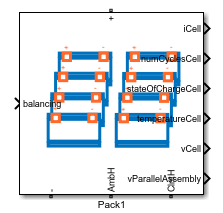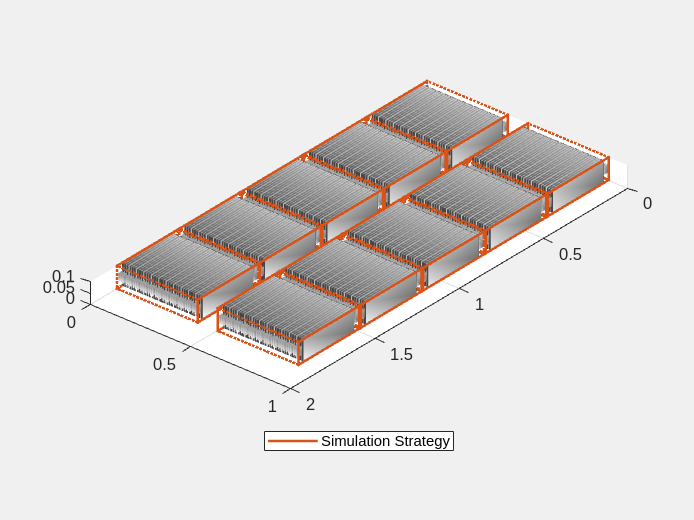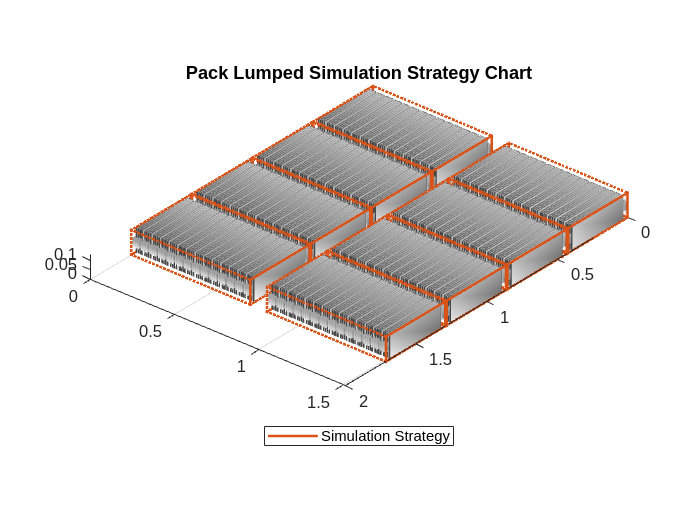Pack (Generated Block)
Description
The Pack block is a custom generated subsystem model of a battery pack. You can create
this Simscape™ subsystem by using the buildBattery
function with a Pack object as an
input argument. The Pack subsystem block is inside the Simulink® library that you specify in the LibraryName argument of the
buildBattery function.
Note
To allow for structural changes and further customization, when you add the Pack (Generated Block) masked library block from the parent library to a Simulink model, the linked block does not contain the link or path to the parent library block. If you modify any of the battery structural properties, such as NumSeriesAssemblies or NumParallelCells, you must rebuild the original parent library and copy the block in your model again.
For more information about parent and linked blocks, see Linked Blocks.
The Pack subsystem model comprises six major sections.
The Battery Module Assemblies section displays all the ModuleAssembly subsystems defined in the
Packobject. This section contains all the series and parallel electrical circuit connections between the module assemblies, as well as the additional connections to the main electrical terminals and the ModuleAssembly-to-thermal boundary conditions. If you require additional non-ModuleAssembly resistances, then the function adds and connects two additional electrical resistors here.The Output signals section groups the output of each ModuleAssembly subsystem into a single multiplexed output signal for the Pack subsystem.
The Thermal Boundary Conditions section contains the thermal boundary conditions for each ModuleAssembly subsystem. The
buildBatteryfunction adds a connector port from the thermal domain and routes it to every ModuleAssembly subsystem according to the specified thermal boundary conditions. This section is optional and only appears if you define an ambient or coolant thermal path in thePackobject.The Balancing Signals section contains the routing of the cell balancing control signal from the battery management system to every ModuleAssembly subsystem. Selector blocks route the correct elements of the control signal to their corresponding ParallelAssembly blocks.
The Coolant Thermal Liquid section contains the thermal liquid network manifold for the coolant that circulates inside the battery cooling plates. This section is optional and only appears if you define a cooling plate in the
Packobject.The Cell Outputs section groups each output of the cell model block into a corresponding multiplexed output signal for the Pack subsystem.
Battery Module Assemblies
This figure shows the Battery Module Assemblies section for a Pack subsystem made of four battery module assemblies.

Output Signals
This figure shows the Output Signals section for a Pack subsystem made of four battery module assemblies.

Thermal Boundary Conditions
This figure shows the Thermal Boundary Conditions section for a Pack subsystem made of four battery module assemblies.

Balancing Signals
This figure shows the Balancing Signals section for a Pack subsystem made of four battery module assemblies.

Coolant Thermal Liquid
This figure shows the Coolant Thermal Liquid section for a Pack subsystem made of four battery module assemblies.

Examples
Ports
Input
Output
Conserving
Version History
Introduced in R2022bSee Also
Apps
Simscape Blocks
- Array of Thermal Nodes Connector | ParallelAssembly (Generated Block) | Module (Generated Block) | ModuleAssembly (Generated Block)


